Deborah Swift's Blog, page 14
April 19, 2022
Sea of Shadows by Amy Maroney #CoffeePotBookClub #Rhodes #Greece #History
The new novel by Amy Maroney is a stunner. Here is the blurb:
A gifted woman artist. A ruthless Scottish privateer. And an audacious plan that throws them together—with dangerous consequences.No one on the Greek island of Rhodes suspects Anica is responsible for her Venetian father’s exquisite portraits, least of all her wealthy fiancé. But her father’s vision is failing, and with every passing day it’s more difficult to conceal the truth.
When their secret is discovered by a powerful knight of the Order of St. John, Anica must act quickly to salvage her father’s honor and her own future. Desperate, she enlists the help of a fierce Scottish privateer named Drummond. Together, they craft a daring plan to restore her father’s sight.
There’s only one problem—she never imagined falling in love with her accomplice.
Before their plan can unfold, a shocking scandal involving the knights puts Anica’s entire family at risk. Her only hope is to turn to Drummond once again, defying her parents, her betrothed, even the Grand Master of the Knights himself. But can she survive the consequences?
With this captivating tale of passion, courage, and loyalty, Amy Maroney brings a lost, dazzling world to vivid life.
Sea of Shadows is Book 2 in a series of stand-alone historical novels packed with adventure and romance.
This is the second book of this series but can absolutely be read as a stand-alone novel. Historical fiction fans will love the carefully evoked detail of the island of Rhodes, and the two main protagonists, Anica Foscolo an artist desperate to learn to paint in oils, and Drummond Fordun a courageous Scottish privateer. Though this is a romance, there is plenty of action, for Rhodes in the middle ages was a hotbed of piracy, slavery and religious tension. It is also a dangerous place, for here a servant can lose an ear or a hand if they steal or lie.
As well as the main characters, I really appreciated the fully-rounded secondary characters – Heleni, the flirtatious and selfish sister, Aunt Rhea the forthright business woman, and Troilo Salviati from the grasping Florentine family we love to hate, to mention only a few. I don’t want to spoil the plot, as it contains many surprises for the reader to enjoy.
In the novel we learn about the new technique of oil painting, with its imported linseed oil, as well as the life of a man at sea and the defences of the island from invaders by the Knights from the forts around the island. I highly recommend this novel of action, adventure and romance to anyone seeking a well-written historical novel with an unusual setting. A novel that lives up to its cover and won’t disappoint.
READ AN EXCERPT
Summer, 1459
Aegean Sea
The rising sun warmed Drummond Fordun’s back and cast a golden glow on the familiar curves of Rhodes. Shifting waters spread out before him, blue-black as a raven’s wing. He stared mesmerized at the waves for a moment, savoring the dance of light and color. Scotland’s sea had never inspired awe in him as the Aegean did. Then again, all this beauty came with a price.
He glanced over his shoulder at the distant shores of Turkey. No swift Turkish fuste were in pursuit, he saw with relief, but that meant nothing. Infidels could be gathering in coastal villages or quiet coves along those shores even now, preparing their sleek vessels to launch an assault on Rhodes tonight.
Overhead, the sails billowed and snapped in the shifting breeze. The wind had been their ally on thevoyage south to Alexandria. The return journey was a different story. A sudden gale had scattered their convoy like errant twigs, cracking one galley’s mainsail mast. The craft trailed the convoy now, a lame sheep struggling to keep up with the flock. Drummond prayed no further harm would come to the damaged ship or its crew.
He strode to the steps leading to the hold. “I see Rhodes!” he bellowed. “Your wives and families await!”
A cheer went up from the rowers on their benches below decks, soon followed by the lilting refrain of a Greek folk song. As usual, his Rhodian oarsmen brightened at the thought of home—and the extra pay Drummond would portion out as soon as they docked. He knew how to keep his men
loyal.
Drummond signaled to his Genoese first mate, a mercenary who’d seen years of action on these seas and was as handy with a crossbow as he was with a compass. “More power from the starboard oarsmen when the harbor walls come into view,” he ordered. “This wind has half a mind to blow us to the Black Sea.”
“As you command, Captain,” the Genoese said in his best approximation of Scots-accented English.
“Och,” Drummond said. “You’ve been practicing. I’m impressed.”
The man put a hand to his chest and bowed slightly. “Grazie.”
Two gulls appeared over the galley and glided on a current of air near the mainsail mast, studying the men with cold yellow eyes.
“We’ve got nothing for you,” the Genoese informed the birds. “If it’s fish you’re after, or biscuit, you’d best look elsewhere.”
It was true. Their hold was nearly empty. Besides ballast, the last soggy rations, and the ever- present barrels of wine and ale, they’d little to show for the journey. But that was as planned. A small wooden box, a letter for the Order’s grand master from the Mamluk Sultanate of Egypt, and several passengers were the only items of value they’d brought back from Africa.
“The lighter the load, the swifter the journey,” Drummond said. “Once we dock, see that the galley is tied up and put to rights. I’ve got to escort the knights to the palace—if we can get through the crowds. With this merchant fleet coming in, the harbor will be jammed.”
“What about our special guest?” the Genoese asked, jerking his head at the figure shrouded in a dun-colored silk cloak who sat under a canvas shade at the stern of the galley. “Is he a man or a statue, I wonder? Every time I glance his way, he’s sitting like a lump of stone.”
Drummond kept his eyes on the island ahead. “He moves. And talks.”
“You speak to him?” The Genoese looked astonished.
“He’s an interesting fellow.”
“Careful what you say to the man. You know these infidels. Can’t be trusted, no matter how charming they seem.”
Drummond raised an eyebrow. “Who made you the expert on Syrians?”
His crewman shrugged. “Syrians, Turks, Egyptians. They’d slit our throats to a man if given half a chance.”
“In this case, you’re mistaken. He’s saved more lives than you or I can imagine. And Christian ones at that.”
“How so?” The Genoese seemed genuinely mystified.
A gust of wind flapped the sails, died down, then rose again.
“This wind’s no help, and we’re close enough,” Drummond said, ignoring the question. “Have the crew trim the yards and sails.”
The stone towers standing sentinel over Rhodes harbor came into view as the Genoese turned away, dispensing orders to the crew. A fleet of merchant ships was clustered at the entrance to the commercial harbor, which was already crowded with vessels. Small rowboats ferrying goods from the ships to the quays wove in and out of the bobbing crafts. Two light galleys rowed past the chaos, heading toward the Mandraki, the Order’s military harbor.
Drummond drew in a breath and bellowed, “Let’s skim around this tangle of ships and follow those galleys to the Mandraki.”
The familiar sounds of the harbor descended upon them. Men shouting, the clang of iron on rock from the weapons arsenal under construction nearby, the harsh screams of seabirds circling overhead. Citizens of the city streamed through gates in the massive stone walls, attracted by the
arriving fleet.
As they entered the calm waters of the inner harbor, the tension Drummond had carried in his chest ever since they’d left Alexandria began to ease. For a moment, he allowed himself to imagine the night ahead. Dice, cards, a big meal, a visit to the bathhouse, perhaps a few hours in the city’s finest brothel—or a visit to the lovely Genoese courtesan who kept a private apartment near the marketplace. Then a long, peaceful night of rest in his rented chambers near the Inn of the English. The possibilities swam in his mind, tantalizing him.
Reluctantly, he pushed them aside. The first orders of business were tying up the galley, paying his rowers, transferring three of his passengers to the palace, and delivering a letter to the grand master. Only after all of that would he have an opportunity to relax. “Prepare to dock!” he called as the galley slipped through the water toward the quay. “Let’s show the Order how a landing should be done!”
Buy Links: This novel is available on #KindleUnlimited
BUY THE BOOK https://mybook.to/SeaOfShadows
About Amy Maroney
Amy Maroney studied English Literature at Boston University and worked for many years as a writer and editor of nonfiction. She lives in Oregon, U.S.A. with her family. When she’s not diving down research rabbit holes, she enjoys hiking, dancing, traveling, and reading. Amy is the author of The Miramonde Series, an award-winning historical fiction trilogy about a Renaissance-era female artist and the modern-day scholar on her trail. Her new historical suspense/romance series, Sea and Stone Chronicles, is set in medieval Rhodes and Cyprus. Website: https://www.amymaroney.com/
Twitter:@wilaroney
Facebook: www.facebook.com/amymaroneyauthor
The post Sea of Shadows by Amy Maroney #CoffeePotBookClub #Rhodes #Greece #History first appeared on Deborah Swift.April 12, 2022
When the Mermaid Sings by Helen Hollick #Extract #CoffeePotBookClub #ShortStory
When the Mermaid Sings by Helen Hollick
A prequel short read story to the Sea Witch Voyages of Captain Jesamiah Acorne
When the only choice is to run, where do you run to?
When the only sound is the song of the sea, do you listen?
Or do you drown in the embrace of a mermaid?
Throughout childhood, Jesamiah Mereno has suffered the bullying of his elder half-brother. Then, not quite fifteen years old, and on the day they bury their father, Jesamiah hits back. In consequence, he flees his Virginia home, changes his name to Jesamiah Acorne, and joins the crew of his father’s seafaring friend, Captain Malachias Taylor, aboard the privateer, Mermaid.
He makes enemies, sees the ghost of his father, wonders who is the Cornish girl he hears in his mind – and tries to avoid the beguiling lure of a sensuous mermaid…
An early coming-of-age tale of the young Jesamiah Acorne, set in the years before he becomes a pirate and Captain of the Sea Witch.
A DISPATCH FROM THE AUTHOR – HAPPY BIRTHDAY HELEN!
Today, 13th April, is my birthday. (I can’t believe that I’m 69!) so the excerpt I have chosen for today – although a different date – is also my pirate’s birthday. But his is slightly more adventurous than mine!
A brief bit about the Sea Witch Voyages:
I wrote the first Voyage (Sea Witch) back in 2005 after thoroughly enjoying the first Pirates of the Caribbean movie. Like most avid readers, however, I wanted more than just the movie, I wanted to read something that was as entertaining and as exciting. A nautical adventure with a charming rogue of a pirate captain, written for adults (with adult content) but with a dash of supernatural fantasy as well – elements of which had made that first movie such fun to watch. I found many nautical-based novels, but they were all ‘serious stuff’ – Patrick O’Brian, Alexander Kent, C. S.Forrester … all good reads but without the fantasy fun, and barely a female character in sight. I simply could not find the book I wanted to read. So, I wrote my own.
The first Voyage led to more books in the series, and also generated several emails from fans who wanted to know how Jesamiah had become a pirate in the first place. When the Mermaid Sings answers that question.
EXCERPT
Cornwall, England, December 1708
The boy with the black hair had been invading Tiola’s dreams again. She sat in the barn, hidden in the summer-cut hay; she often came here because the smell and the dust made her father sneeze, so he avoided the place, just as she avoided him as much as she could. Her two man-grown brothers had no care for an irritating almost-eight-year-old girl, so neither did they come searching. Her other brothers, Carter and Bennett, nine and three years her elder, preferred to be out in their boat, fishing, unless the Cornish weather was too inclement even for them to tolerate. Her mother knew where and why she sought the solitude, but Mother knew that her only daughter took after her own mother, and respected her especial gift of Fey, and left her to the privacy of
her visionary thoughts. Tiola, named for that same grandmother, was an inquisitive child who behaved older than her years and was full of questions: what are clouds made of? Why is the sky blue? How wide is the sea? Who is the boy I see in my dreams? She had asked that last question only once. The resulting whipping from her father, the Reverend Garrick, had taught her the prudence of silence.
2
She sighed. Her mother was calling for her to come and help with the afternoon chores. All Tiola wanted to know was the identity of the boy with black, curly hair. Boy? No, young man now. He had been a boy when first she had watched him, but last night, in her dream, she had clearly seen that he was growing up, maturing into manhood. She had watched him, in her mind, many times; felt his enjoyment as he dabbled with the gentle flow of the river and sailed, or mended, or painted his boat. Had cringed when the shadow of his brother blotted the sun, wept with him when the cruel bullying left its mark of fear and pain. She knew about that wicked shadow of fear, for her father cast the same shadow. She had saved him, the boy, all those months ago, when he had almost given in to the grief of despair, and surrendered to the malignant presence of Death. She had shouted at him with mind-words: ~ Get up! Fight back! ~ But she needed to know who he was because she had to continue to keep close watch over him. Had to keep him safe. How and why, she was not yet certain, but she would find out, one day. Perhaps soon? Or maybe when she was a woman grown, and this embryonic gift of Craft that she possessed, passed from grandmother to granddaughter, was fully awakened?
Read more: How I met Jesamiah Acorne (the tru-ish) story
Praise :
“Ms Hollick has skillfully picked up the threads that she alludes to in the main books and knitted them together to create a Jesamiah that we really didn’t know.” Richard Tearle senior reviewer, Discovering Diamonds
Find Helen on her website: https://www.helenhollick.net
Social Media: Twitter Facebook

BUT MOST IMPORTANTLY –
BUY THE BOOK:
The post When the Mermaid Sings by Helen Hollick #Extract #CoffeePotBookClub #ShortStory first appeared on Deborah Swift.March 23, 2022
The Carnival of Ash by Tom Beckerlegge #Historical #Fantasy #Renaissance
 Today I’m welcoming Tom Beckerlegge to tell us more about his new literary novel, The Carnival of Ash.
Today I’m welcoming Tom Beckerlegge to tell us more about his new literary novel, The Carnival of Ash.
The Carnival of Ash is a historical fantasy set during the Italian Renaissance in an imaginary city called Cadenza, where poets and scholars as its most important citizens. In the wake of the death of Cadenza’s ruler, the book traces the city’s decline and fall through a series of interlinked tales featuring a cast of would-be writers and warring poets, ink maids, psychotic gravediggers, and more than one set of estranged lovers.
The story opens with the arrival of Carlo Mazzoni at the city’s gates. A young poet from the countryside, Carlo’s hopes of making his name rest on verses he has written inspired by the poem De Incendio Urbis (“On the Burning of the City”) by the ancient Roman poet Lucan. Both Lucan and his poem are real, although the latter is a lost work, leaving much of its contents open to debate. It is known that Lucan had been a friend and favourite of the Emperor Nero: in AD 60, he won a prize for his poetry at the quinquennial Neronia, a lavish festival of sport and the arts. But at some point, there was a falling-out. Classical sources differed on the source of the dispute – according to one, Nero had become jealous of his former friend, and forbade him to publish any more poems; according to another, the emperor disrupted a public reading by Lucan by calling a meeting of the Senate. Whatever the truth, a match had been lit; a feud begun that would end in blood.
 In the summer of AD 64, two-thirds of Rome was destroyed in a devastating fire that burned for more than a week. In De Incendio Urbis, Lucan is thought to have directly accused Nero of being complicit in the inferno. The following year, the poet became involved in the conspiracy organised by Gaius Calpurnius Piso to assassinate the emperor. But their plans were exposed on the morning of the murder and the conspirators were rounded up and tortured. The philosopher Seneca –
In the summer of AD 64, two-thirds of Rome was destroyed in a devastating fire that burned for more than a week. In De Incendio Urbis, Lucan is thought to have directly accused Nero of being complicit in the inferno. The following year, the poet became involved in the conspiracy organised by Gaius Calpurnius Piso to assassinate the emperor. But their plans were exposed on the morning of the murder and the conspirators were rounded up and tortured. The philosopher Seneca –
Lucan’s uncle – the satirist Petronius and Lucan himself received orders from Nero to kill themselves. Lucan sliced open a vein and bled to death, reciting his own verses with his last breath. The rich history behind De Incendio Urbis made it irresistible to me, and I had to include it in The Carnival of Ash.
Inspired by the poem, my hero Carlo writes his own version, “City of Flames”, which he dedicates to Cadenza’s all-powerful ruler, Tommaso Cellini – who, in the early years of his reign, had survived his own attempted assassination. Yet Carlo arrives at the city gates to learn that Tommaso is now dead, and he is brutally rejected by the literary circles he hopes to impress. As Cadenza slides into discord and anarchy, Carlo and the city’s inhabitants face a fight if they are to save it from the same fiery fate that Rome suffered.
 As Tom Becker, I’ve been writing children’s books for more than 15 years, and this is my first adult novel. I’ve relished the chance to weave fact and fiction together; I hope that The Carnival of Ash brings Cadenza alive, and that readers can lose themselves in the twists and turns of its streets.
As Tom Becker, I’ve been writing children’s books for more than 15 years, and this is my first adult novel. I’ve relished the chance to weave fact and fiction together; I hope that The Carnival of Ash brings Cadenza alive, and that readers can lose themselves in the twists and turns of its streets.
BUY THE BOOK: mybook.to/CarnivalofAsh Hardback, ebook, audiobook
Find Tom on Twitter: @Tbeckerlegge
Tom’s website: https://tombeckerlegge.wordpress.com/
The paintings of burning Rome are by Hubert Robert, an 18th Century artist who spent eleven years in Rome. (Wikipedia)
The post The Carnival of Ash by Tom Beckerlegge #Historical #Fantasy #Renaissance first appeared on Deborah Swift.February 27, 2022
Naughty Language in Tudor England by Carol McGrath #Tudor #Love #Language
I’ve been looking forward to my guest, Carol McGrath enlightening me about Tudor language, and particularly the naughty words!
 Carol McGrath is the author of the acclaimed She-Wolves Trilogy, which began with the hugely successful The Silken Rose and continues with the brand new The Damask Rose. She was born in Northern Ireland, and fell in love with historical fiction at a young age, reading children’s classics and loving historical novels especially Henry Treece, The Children’s Crusade, and, as a teenager, Anya Seton’s Katherine and everything by Jean Plaidy. Visiting the Tower of London and Hampton Court Palace aged eleven was thrilling for her. Exploring Irish castles such as Carrickfergus introduced her to wonderful stories. At only nine years old an archaeological dig in Donegal was inspirational. Carol came away with a few ancient mammal teeth. While completing a degree in history, she became fascinated by the strong women who were silenced in records, and was inspired to start exploring their lives. Her first novel, The Handfasted Wife, was shortlisted for the Romantic Novelists’ Association Awards, and Mistress Cromwell was widely praised as a timely feminist retelling of Tudor court life. Her novels are known for their intricacy, depth of research and powerful stories.
Carol McGrath is the author of the acclaimed She-Wolves Trilogy, which began with the hugely successful The Silken Rose and continues with the brand new The Damask Rose. She was born in Northern Ireland, and fell in love with historical fiction at a young age, reading children’s classics and loving historical novels especially Henry Treece, The Children’s Crusade, and, as a teenager, Anya Seton’s Katherine and everything by Jean Plaidy. Visiting the Tower of London and Hampton Court Palace aged eleven was thrilling for her. Exploring Irish castles such as Carrickfergus introduced her to wonderful stories. At only nine years old an archaeological dig in Donegal was inspirational. Carol came away with a few ancient mammal teeth. While completing a degree in history, she became fascinated by the strong women who were silenced in records, and was inspired to start exploring their lives. Her first novel, The Handfasted Wife, was shortlisted for the Romantic Novelists’ Association Awards, and Mistress Cromwell was widely praised as a timely feminist retelling of Tudor court life. Her novels are known for their intricacy, depth of research and powerful stories.
Over to Carol!
What might have been said on the street in Tudor England?
Language on the street was, for example, less restrained than, say, that used in literature and poetry. Private manuscripts were often openly sexual in terminology. There is talk of shameful sex in these writings such as weak women ‘giving way’ and of women having ‘no ability to control themselves when faced with male desire’. Society actually believed both sexes gained pleasure from sex and thought an orgasm was essential for a woman to conceive. Society considered that sexual misbehaviour was worse when committed by women than by men. Whilst a man could boast about his powers and his sexual appetite, a woman had to find extenuating circumstances to downplay her choice of actions. A list of sexual insults used in everyday street talk by Tudors includes the words whore, harlot, knave and bawd, which were often used in an aggressive manner. Smell-socks was a term to make fun of one who might sniff a woman’s underwear. Euphemisms for sex included ‘bedsport’, ‘tilling the fields of Venus’, or ‘nice play’ to suggest male and female enthusiasm. Ballads and jokes included a range of slang terms such as ‘pie’, ‘secret parts’, ‘corner’, ‘plum’, ‘hole’ or ‘pond’ for the vagina, and ‘shaft’, ‘pride’, ‘tool’, ‘cock’, ‘prick and ‘horn’ for the penis. Prostitutes were whores, harlots, trulls, jills, drabs, and geese or mackerel. ‘To make a fist’ was a term meaning to masturbate as well as throwing a punch. Here is a further selection of naughty terms that existed in Tudor times.
Assail/assault: laying siege to a body’s chastity. Bawdry: is dirty talk or behaviour and the bawdy-house is the whore house. Bone-ache: pain due to a venereal disease or the disease itself. Cliff: take her cliff is slang for female parts such as clef. Cock: actually also a substitute for God. ‘Cock’s passion’ in Taming of the Shrew, IV. i. 118.

Codpiece: a man’s privies as well as the decorative bag fashionable men like Henry VIII wore. Die: to have an orgasm. Do: all-purpose word for ‘have sex’. Drab: a prostitute. Fig: expletive accompanied by an obscene gesture. Jakes: privy or outhouse. Lap: crotch. Maidenhead: female virginity. Malady of France: the pox. Male varlot: masculine whore. Naughty: lewd. Pap: nipple. Pistol or Pillicock: penis. Play: to sport wantonly. Powdering tub: a heated tub in which one was supposed to sweat a venereal disease. Pox: venereal disease usually syphilis. Privates: secret parts Punk: low-class strumpet. Quean: whore. Stand to: be erect. Stones: male part. Thing: sex organ, male or female. Tool: penis. Top: satisfy a lover. Treasure: a woman’s sexual zone especially a virgin’s sexual zone. Tub-fast: abstinence from food and drink while in the powdering tub. Tup: mating. Virgin knot: hymen. Weapon: male organ in an aggressive state. Will: sexual desire but also referring to sexual organs. Yard: penis.
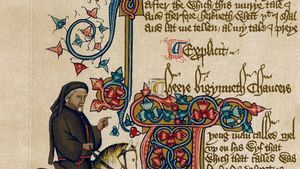
Canterbury Tales (Britannica.com)
During medieval and Tudor times, street names in towns reflected the work done there. For example, Love Lane may reflect a euphemism for prostitution occurring there. London’s Love Lane was formerly Roper Lane, so named for the rope making business or after someone with the surname ‘Roper’. Lovat Street was thought a corruption of Lucas, a local landowner, but it was formerly Love Lane and was changed to avoid confusion with London’s other Love Lane. Stew Lane was named after the former stew or hot steamy bath that existed on premises there. Grope or Cunt Lane was common in towns. The meaning of the word grope was to clasp hands or grab. It has not significantly changed its meaning to this day. Grope Lanes can be found in many English towns of the era such as Norwich, Bristol, York, Shrewsbury, Whitby, Wells, Newcastle and others. These lanes were narrow, dark alleys or passageways rather than actual streets. They were usually close to a town’s commercial centre, close to market places, high streets or public quays, or near churches. This raises the question: did travellers and clergy as well as perhaps parishioners routinely resort to prostitutes? Oxford’s Cocks Lane appears to be a place of illicit sex. In Piers Plowman by William Langland there is a reference to ‘Clarisse of Cokkes Lane.’

Piers Plowman Manuscript (Wikipedia)
Like many other towns of the era, Cambridge hosted traditional fairs. The Stourbridge Fair lasted for a full month and sold luxury and everyday items. However, behind the tempting booths, one might discover equally appealing purpose-built bedrooms. During the fair streets would assume temporary names. One such street was named Oyster Row. Either oysters could be purchased there or sex, or, enticingly, both: ‘they (hawkers) mingled with the poorest of the fair’s customers and the rag-tag assortment of beggars, petty thieves and prostitutes also hoping to make their way.’ The Cambridge Stourbridge Fair attracted many sex workers during the early 1500s and prostitutes would move between fairs. Perhaps the next time you are in one of the above mentioned cities you might keep an eye out for sexually explicit names reaching back centuries and indicative of places where, during the sixteenth century, a needy man, priest or youth might seek sex. Next time you watch a Shakespeare play do consider the saucy language he used – commonplace in Tudor society – as euphemism or when punning, explicitly sexual and very often sexist to our twenty-first century, liberated ears but also titillating and very entertaining.
SEX AND SEXUALITY IN TUDOR ENGLAND
The Tudor period has long gripped our imaginations. Because we have consumed so many costume dramas on TV and film, read so many histories, factual or romanticised, we think we know how this society operated. We know they ‘did’ romance but how did they do sex? In this affectionate, informative and fascinating look at sex and sexuality in Tudor times, author Carol McGrath peeks beneath the bedsheets of late fifteenth- and early sixteenth-century England to offer a genuine understanding of the romantic and sexual habits of our Tudor ancestors. Find out the truth about ‘swiving’, ‘bawds’, ‘shaking the sheets’ and ‘the deed of darkness’. Discover the infamous indiscretions and scandals, feast day rituals, the Southwark Stews, and even city streets whose names indicated their use for sexual pleasure. Explore Tudor fashion: the codpiece, slashed hose and doublets, women’s layered dressing with partlets, overgowns and stomachers laced tightly in place. What was the Church view on morality, witchcraft and the female body? On which days could married couples indulge in sex and why? How were same sex relationships perceived? How common was adultery? How did they deal with contraception and how did Tudors attempt to cure venereal disease? And how did people bend and ignore all these rules?
For more news from Carol, exclusive content and competitions, sign up to Carol’s newsletter at http://www.carolcmcgrath.co.uk. or ollow her on Facebook: /CarolMcGrathAuthor1 and on Twitter: @CarolMcGrath
The post Naughty Language in Tudor England by Carol McGrath #Tudor #Love #Language first appeared on Deborah Swift.February 16, 2022
Richard II’s London by Mercedes Rochelle #blog #CoffeePotBookClub #HistoricalFiction
I’m thrilled to bring you an excellent post from Mercedes Rochelle about London in the time of Richard II. Thank you Mercedes!
 While researching this novel I had the good fortune to stumble across the book “The Turbulent London of Richard II”—not, as it turns out, because of the content. It was way too specialized for me. But it came with the most awesome fold-out “sketch map of London in the time of the Peasant Revolt” that I photocopied and taped to my wall. It’s still there, three novels later. I spent hours scrutinizing it until I had a faithful understanding of England’s most important city, most of which was still tucked inside of the old Roman walls.
While researching this novel I had the good fortune to stumble across the book “The Turbulent London of Richard II”—not, as it turns out, because of the content. It was way too specialized for me. But it came with the most awesome fold-out “sketch map of London in the time of the Peasant Revolt” that I photocopied and taped to my wall. It’s still there, three novels later. I spent hours scrutinizing it until I had a faithful understanding of England’s most important city, most of which was still tucked inside of the old Roman walls.
This was important, for at the time of the Peasants Revolt, the city officials relied on the wall to keep the rebels out. There were seven gates in the Roman wall: Ludgate (facing west), Newgate (where the prison was), Aldersgate (facing Smithfield), Cripplegate, Bishopsgate, Aldgate (east, facing Mile End), and the Postern Gate at the Tower of London (pedestrian only). The only other way into London was over the London Bridge, which had a drawbridge at the Southwark end. Of course, the mayor of London was dependent on the loyalty of his gatekeepers, and this ultimately failed him. Once Aldgate was opened and the insurgents came pouring into the city from the east, he had no choice but to lower the drawbridge and give passage to the Kent rebels.
London Bridge was a world all its own, populated by every conceivable business except taverns—for they had no cellars. The shops occupied the ground floor with their colorful signs nine feet above the pavement so a horse and rider could pass underneath. Every sign displayed an image representing a trade so it could be identified by anyone, literate or not. The bridge was twenty feet wide, lined on both sides by buildings cantilevered over the edge, supported by huge wooden struts. Each house only occupied four feet of the stone platform; which meant that only twelve feet was left to accommodate the road. Two and three stories high, the houses blocked out the sun like a tunnel, especially since many of the top floors were connected by an enclosed walkway. This would have been the conduit through which thousands and thousands of rebels pushed their way into the city. At this stage of the rebellion they were exhorted by their leaders to be well-behaved, though I can only imagine the trepidation felt by the hapless shopkeepers.
Interestingly, one of the rebels’ first targets was John of Gaunt’s great Savoy palace, which was the most elegant townhouse in all of London. It bordered the river, upstream on the way to Westminster along the Strand. The Strand was the London version of Millionaire’s Row: wealthy riverfront properties free of the stink and pollution of the city. To get to the Strand, you had to pass out through Ludgate then cross the Fleet, an open sewer polluted by the butchers and tanners dumping their refuse into the River Holborn—not to mention the prison sewage. The Fleet in turn poured its stinking offal into the Thames. And that’s not all: at certain docks along the river contained laystalls (think Dicken’s Puddle Dock, at Black Friars). This is where the night soil, or human excrement, was piled up, eventually to be taken away by five barges located downstream. You can just imagine the horrific stench.

Savoy Palace from the later date of 1650 from British History Online
Anyway, the rebels had to pass the famous Knights Hospitaller Temple along the way to the Savoy (they would be back—that’s where the lawyers lived). You also had Durham House (residence of the Bishop of Durham), York House (for the Bishop of York), the convent of the White Friars…you get the idea. I don’t think any of these palaces escaped the attention of the insurgents. Once they destroyed the Savoy—literally, for they accidentally blew it up with barrels of gunpowder, trapping many of the rebels in the cellar—they rampaged their way back into the city, spreading out in their efforts to eliminate the hated foreigners who competed for jobs and took food from their mouths. Oh, and to see how much plunder they could amass.
During the early phase of the Peasants’ Revolt, the king and his few nobles took refuge in the Tower of London, alleged to be invulnerable to attack. And it probably would be, though any fortress is only as strong as its human defenders. While Richard and party were at Mile End negotiating with the rebels on day two, the troublemakers remaining in the city forced their way in and seized the Archbishop of Canterbury and Treasurer Hales, decapitating them in the process. How? No one knows, but since the Tower defenders were commoners, one can only assume they were persuaded to join the cause.
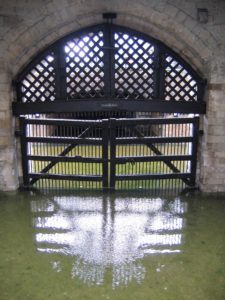 Above: Tower of London, Watergate
Above: Tower of London, Watergate
After two days of rioting, the rebels finally agreed to meet King Richard at Smithfield, approached through Aldersgate. Just north of the city walls, Smithfield was an open space so large it would take about ten days for a yoke of oxen to plow it. Every August since the time of Henry I, the famous Bartholomew Fair was held there, bringing people from all over the country. Otherwise, Smithfield was most often used as a horse market, though sometimes it hosted sporting games, tournaments, and even executions. The Scottish rebel, William Wallace, was hanged, drawn, and quartered in this very spot, under the elms in the far northwest corner. This time it was the turn of Wat Tyler, who led his rowdy followers to Smithfield in an attempt to wrest more concessions from the king. Unfortunately for Wat, this would be the site of his untimely end, as well. And in the confusion, the rebels had nowhere to go but north toward Clerkenwell Fields, for the way out was blocked by the Roman wall to the south, the Fleet to the west, and the Priory of St. Bartholomew to the east. A brave and resilient King Richard led the way and the chastened rebels followed. Once they were brought under control, the Essex rebels scattered to the north, but the Kent contingent was led back through the city and over the London Bridge again; this time their behavior was impeccable (under pain of death).
By all accounts, a tremendous amount of damage was done to London during the Peasants’ Revolt, but of course it survived. One wonders why it didn’t go up in flames like the Great Fire of 1666, but perhaps the violence was directed more against people than structures?

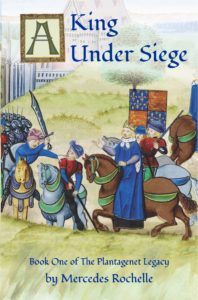 A KING UNDER SIEGE by Mercedes Rochelle
A KING UNDER SIEGE by Mercedes Rochelle
Richard II found himself under siege not once, but twice in his minority. Crowned king at age ten, he was only fourteen when the Peasants’ Revolt terrorized London. But he proved himself every bit the Plantagenet successor, facing Wat Tyler and the rebels when all seemed lost. Alas, his triumph was short-lived, and for the next ten years he struggled to assert himself against his uncles and increasingly hostile nobles. Just like in the days of his great-grandfather Edward II, vengeful magnates strove to separate him from his friends and advisors, and even threatened to depose him if he refused to do their bidding. The Lords Appellant, as they came to be known, purged the royal household with the help of the Merciless Parliament. They murdered his closest allies, leaving the King alone and defenseless. He would never forget his humiliation at the hands of his subjects. Richard’s inability to protect his adherents would haunt him for the rest of his life, and he vowed that next time, retribution would be his.
BUY THE BOOK: https://books2read.com/u/brap6A
Get in touch with Mercedes :
Website: https://www.MercedesRochelle.com
Twitter: http://www.Twitter.com/authorRochelle
Facebook: facebook.com/MercedesRochelle.net
The post Richard II’s London by Mercedes Rochelle #blog #CoffeePotBookClub #HistoricalFiction first appeared on Deborah Swift.January 23, 2022
Author Spotlight – Kerry Chaput, Daughter of the King #CoffeePotBookClub #17thCentury
I’m delighted to spotlight historical fiction author Kerry Chaput today, especially as her book is set in the 17th Cerntury, one of my favourite periods.
Born in California wine country, Kerry Chaput began writing shortly after earning her Doctorate degree. Her love of storytelling began with a food blog and developed over the years to writing historical fiction novels. Raised by a teacher of US history, she has always been fascinated by tales from our past and is forever intrigued by the untold stories of brave women. She lives in beautiful Bend, Oregon with her husband, two daughters, and two rescue pups. She can often be found on hiking trails or in coffee shops.
From Kerry:

I’m proof that it’s never too late to change your life.
When I was younger I had dreams of becoming a writer. My family thought it sounded like a frivolous and unattainable dream. So I chose the responsible route. A solid, safe career. When I turned twenty-five, I sat down to write my first story. I saved it to the hard drive and never spoke of it again. Who was I to think I could be a writer?
After working for over a decade as a physical therapist, I found myself with a bunch of degrees, forty years old, two little kids, and completely burned out. I took some time off to just be a mom and breathe into the moment of my life.
That story started nudging me, fifteen years after I shelved it. That’s one great thing about being forty, you care less about making excuses. I started writing it again, and it was exhilarating. Every morning in the dark, every naptime, I wrote. I didn’t know what I was doing, but I knew that I was changed. I finally found the courage to be a writer. Or it found me.
Writing has turned into a love (some may say obsession) for historical women’s fiction. All my stories explore the journey of women and their mark on history. I’ve completed my fourth novel, with many more in the works.
Born a California girl, I now live in Bend, Oregon where I can be found hiking and enjoying the amazing trails of the Pacific Northwest. I live with my husband, two children, and two dogs, sharing the love of Oregon and finding inspiration in the world around me for my writing.
I hope you enjoy my stories as much as I love writing them.
Kerry has a popular blog – Sip Coffee, Savor Books…
I believe in warm drinks and tall tales. I love historical fiction stories that transport me back in time. Stories of resilience and women overcoming the impossible. I write to bring them to life, one page, and one sip at a time.
Read Kerry’s blog about what she learned on her way to publication: https://www.kerrywrites.com/post/ten-things-i-ve-learned-on-the-journey-to-publication
Social Media Links:
Website: https://kerrywrites.com Twitter: https://twitter.com/chaputkerry Amazon Author Page: https://www.amazon.com/Kerry-Chaput/e/B08123S61Z
About the book, DAUGHTER of the KING
La Rochelle France, 1661. Fierce Protestant Isabelle is desperate to escape persecution by the Catholic King. Isabelle is tortured and harassed, her people forced to convert to the religion that rules the land. She risks her life by helping her fellow Protestants, which is forbidden by the powers of France. She accepts her fate — until she meets a handsome Catholic soldier who makes her question everything.
She fights off an attack by a nobleman, and the only way to save herself is to flee to the colony of Canada as a Daughter of the King. She can have money, protection and a new life — if she adopts the religion she’s spent a lifetime fighting. She must leave her homeland and the promises of her past. In the wild land of Canada, Isabelle finds that her search for love and faith has just begun.
Based on the incredible true story of the French orphans who settled Canada, Daughter of the King is a sweeping tale of one young woman’s fight for true freedom. Kerry Chaput brings the past to life, expertly weaving a gripping saga with vivid historical details. Jump back in time on a thrilling adventure with an unforgettable heroine.
The post Author Spotlight – Kerry Chaput, Daughter of the King #CoffeePotBookClub #17thCentury first appeared on Deborah Swift.January 15, 2022
Audiences Behaving Badly – The London Theatre in the 1660’s
Theatre Ticket
Crowd Pleaser
In my novel, Entertaining Mr Pepys, the main character ‘Bird’ Knepp, so named for her beautiful singing voice, is an actress with the King’s Playhouse in the city of London, just before the Great Fire. As an actress her job was to please the audience – but the audience of the time was not nearly so well-behaved as it is now, and what’s more it was much larger than today; “by 2 a-clock, there was 1000 people put back that could not have room in the pit,” wrote Pepys. (Diary, 6 February, 1668.)
In the theatre there were three places to sit – first, the pit, closest to the stage, well-lit, but rough and ready. “The Pit is an Amphitheatre, fill’d with Benches without Backboards, and adorn’d and cover’d with green Cloth. . . “ Henri Misson, visitor to London in the 1690s.
Fights in The Pit
The audience in the pit included ‘prentices’ (young men apprenticed in trade) but also “Men of Quality, particularly the younger sort, Some Ladies of Reputation and Vertue, and abundance of Damsels that hunt for Prey …” (Henri Misson) All these were crushed together, and wealthy patrons avoided it if they could. Tensions often ran high in this confined space.
In a letter to a relation John Verney tells us of a fight in the pit, “On Saturday last, at the Duke’s Playhouse, Sir Thomas Armstrong killed Mr Scrope….their quarrel is said to be about Mrs Uphill, the player”. Apparently this was a row over a woman, but a circle was formed around them, and the two men fought to the death right in front of the assembled audience. I don’t suppose the actual play held many surprises after that!
The Box – a stage in itself
The alternative was a box, above the stage and more expensive. From the box you could both see the play and be seen. A box was a sign of higher status because of its expense, and because you were higher than, and immediately visible to, those in the pit. The first time Samuel Pepys paid for a box, he says;
“And this pleasure I had, that from this place the scenes do appear very fine indeed and much better than in the pit.”
The boxes were also miniature stages in themselves, where audiences could gawp at the sexual politics of the day. At the play The Jovial Crew, Pepys witnessed the onset of the King’s rampant affair with Barbara Palmer, Lady Castlemaine. The King’s mistress, always flamboyantly dressed, often appeared at the theatre bedecked in jewels that the impoverished populace had paid for with their taxes.

The Beggars Opera
Those in the boxes often performed from there, making welcome – or unwelcome – observations on the play. Sir Charles Sedley and his female companion did just that, and Pepys tells us ‘He was mighty witty … But by that means I lost the pleasure of the play wholly, to which now and then Sir Charles Sedley’s exceptions against both words and pronouncing was very pretty.’
The Gallery – Beware of Spit
The middle ground was the gallery, which cost 12 pence as opposed to five shillings for a box. There you were in danger of being spat on, “And here, I sitting behind in a dark place, a lady spat backward upon me by a mistake, not seeing me. But after seeing her to be a very pretty lady, I was not troubled at it at all.” (Pepys 28 January, 1661.)
Even in the gallery though, disturbances could wreck a performance. The Custom of the Country was apparently ‘so damned bawdy that the ladies flung their pears and fruits at the actors.’ Women’s vocal outrage against the male-orientated, rakish comedies is said to have ruined many a play.
In the prologues of many plays of this period, which are meant to address the audience directly, we read of ‘fop alley’, ‘wits’ corner’, ‘punks’ boxes’ and ‘bullies’ benches’. All these point to a lively dialogue between actor and badly-behaved audience, and one I would love to have witnessed.
Sources
Audience, Playhouse and Play in Restoration Theatre, 1660-1710 – Allan Botica, Bodleian Library
Restoration Plays and Players – David Roberts Cambridge University Press
Pictures from Wikicommons
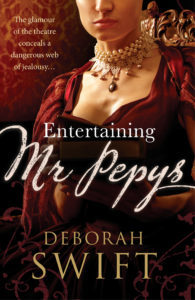 ‘Entertaining Mr Pepys’ is published by Accent Press in ebook, paperback & audio.
‘Entertaining Mr Pepys’ is published by Accent Press in ebook, paperback & audio.
Follow Deborah on Bookbub for all her bargain books.
The post Audiences Behaving Badly – The London Theatre in the 1660’s first appeared on Deborah Swift.January 6, 2022
1066 Upside Down – alternative histories – To Crown a King by Helen Hollick #CoffeePotBookClub
Today I present an excerpt from 1066 Turned Upside Down by Helen Hollick
To Crown A King
by Helen Hollick
An appropriate excerpt, for on January 6th in 1066 Harold Godwinson was crowned as King of England…
King Edward, later known as ‘The Confessor’ died on 5th January 1066, just days after his Abbey of Westminster was dedicated to God. Within hours, his Earl of Wessex, Harold Godwinson, was crowned King of England – in unseemly haste, the Normans later claimed. Not so, Edward’s earls and nobles had been at the Christmas Court for many weeks and wanted to return to their lands, the next opportunity for a crowning would not have been until Easter. The ‘haste’ was perfectly normal for English law and custom.
The Normans also claimed that the childless Edward sent Harold to Normandy in the 1060s to offer the crown to William. This would have been highly unlikely: the English earls would not have sanctioned it and it was for the Witan, the Council, to elect a king – usually the eldest son, but it could be the man most worthy to do the job. And there was already a legitimate heir, Edgar, the young grandson of Edward’s half-brother, Edmund Ironside. In 1066, Edgar was only about thirteen years of age…
Westminster, London – January 6th 1066
The murmur of conversation was low within the council chamber, flickering in unison with the draught-disturbed candle flames. All but a few of the Witan were present. Nine and thirty men including two archbishops: Stigand of Canterbury and Ealdred of York.
Archbishop Ealdred stood and cleared his throat. ‘My lords, we must, no matter that it is hard to do so, discuss what we all shy from.’
The light talk faded, grim faces turned to him, men settled themselves on benches or stools, a few remained standing.
‘It is doubted that Edward will survive this night. It is our duty, our responsibility, to choose the man who is to take up his crown, to decide our next king.’ Ealdred folded his robes around him and sat.
Those present were suddenly animated; opinions rose and fell like a stick of wood bobbing about on an incoming tide. Only two names were on their lips: Edgar, the boy ætheling, and Harold.
The two in question sat quiet on opposite sides of the chamber: one asking himself if this was what he wanted; the other, bewildered and hiding his fear. Edgar had never before been summoned to attend the council. It was not a thing for a boy not yet three and ten years of age, this was the world of men, of warlords and leaders. He looked from one to another, listened to snatches of the talk. Earlier that evening he had been immersed in a game of taefl with his best friend – had been winning. He stifled a yawn. Fought against closing his eyes to doze.
For an hour the men debated. Occasionally someone would toss out a sharp question to the boy, who startled awake, or to Harold, seeking opinion, assurance. Edgar answered as well he could. Harold with patient politeness.
‘As I see things,’ Stigand said, his voice pitched to drown the rattle of debate, ‘we have talked of but two contenders. Edgar?’ He beckoned the lad forward. He came hesitantly, not much caring for this direct focus of attention for he was a shy boy.
Stigand continued, not noticing the reluctance. To be king was a thing sanctioned by God, personal feeling did not come into it. ‘He is of the royal blood, but not of age. Second, Harold of Wessex.’ Again the archbishop paused to motion the man forward. ‘He has ruled England on Edward’s behalf and has proven himself a wise and capable man, but there is a third possibility. Duke William of Normandy may claim the crown through the blood-tie of King Edward’s lady mother, Queen Emma – God rest her soul – and through some misguided impression that Edward did once offer him the title.’
Immediately there were mutterings, shaking of heads, tutting. Upstart Norman dukes were unanimously declared as not understanding the civilised ways of the English.
Stigand half smiled, said, ‘I take it, then, that William is excluded from the voting?’
‘Aye.’
‘That he is!’
‘Duke William cannot be so easily dismissed,’ Harold interrupted. He waited for the babble of voices to quieten. ‘He will not heed anything said in this room, no matter how scornful or vehement. If he has set his mind on wearing a crown, then he will attempt to take it. If he is rejected, the question will not be if, how, or can he attack us, but when.
Does Harold become king in this alternative history story? Find out in 1066 Turned Upside Down – an anthology of alternate tellings of history
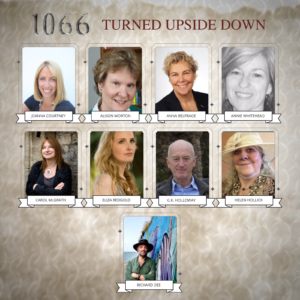
Have you ever wondered what might have happened if William the Conqueror had been beaten at Hastings in 1066? Or if Harald Hardrada had won at Stamford Bridge? Or if Edward the Confessor had died with an heir ready to take his crown? If so – here is the perfect set of short stories for you.
1066 Turned Upside Down explores a variety of ways in which that momentous year could have played out very differently.
Written by nine well-known authors the stories will take you on a journey through the speculative ‘what ifs?’ of England’s most famous year in history.
READERS’ COMMENTS
“1066 Turned Upside Down is the exemplar for how analytical counterfactual history should be done, combining the best elements of fiction and non-fiction to create an immensely impressive achievement.”
“As a collection, the quality of the writing is exceptional and the variety of possible outcomes presented is truly fascinating.”
About Helen: HELEN HOLLICK moved from London in 2013 and now lives on a thirteen-acre farm in North Devon, England. Born in London, Helen wrote pony stories as a teenager, moved to science fiction and fantasy, and then discovered the wonder of historical fiction. Published since 1994 with her Arthurian Pendragon’s Banner Trilogy, followed by her 1066 era duo. She became a USA Today bestseller with her story of Queen Emma: The Forever Queen (titled A Hollow Crown in the UK), and its companion novel, Harold the King (titled I Am the Chosen King in the U.S.A). She also writes the Sea Witch Voyages, a series of pirate-based nautical adventures with a touch of fantasy. Commissioned by Amberley Press she wrote a non-fiction book about pirates in fact, fantasy and fiction and a non-fiction book about smugglers, published by Pen and Sword.
Recently she has ventured into the ‘Cosy Mystery’ genre with her Jan Christopher Mysteries, the first of which is A Mirror Murder. She runs Discovering Diamonds, an independent online review site for Historical Fiction, primarily aimed at showcasing Indie writers.
She occasionally gets time to write. Find her at www.helenhollick.net
The post 1066 Upside Down – alternative histories – To Crown a King by Helen Hollick #CoffeePotBookClub first appeared on Deborah Swift.December 6, 2021
Fair Mountain Christmas by Heidi Eljarbo #CoffeePotBookClub #Review
Review
A real comfort-blanket of a book!
I’ve been getting into the Christmas spirit this week, and what better way to do it than with a heart-warming novella set in Norway! Plenty of snow in this one, along with a schooldays friend who turns out to be more than a friend, a loveable dog and all the scents of winter – pine logs, cinnamon bakes and frosty air. When Juni Lind has a writing assisgnment to do, she thinks a few weeks in her grandmother’s cottage will be just the place for a retreat. She also has to consider the true meaning of Christmas and the things money can’t buy – follow her in this delightful tale of old memories, waaaaay too much snow and an unexpected romance! Guaranteed to get you in the mood for Christmas. Highly recommended.
Nostalgia and Christmas miracles burn bright in this uplifting and heartwarming story about new beginnings and falling in love under a blanket of stars.
Fair Mountain, December 1972.
A few days before Christmas, Juni’s editor gives her a writing assignment that throws her far outside her comfort zone. She and her terrier, Leo, retreat to her grandparents’ old cabin in the Norwegian mountains in hopes of inspiration. But the trip turns into a heart-wrenching and emotionally challenging encounter.
Memories of Juni’s childhood seep in as soon as she enters the cabin, and as for the writing assignment…what does she know about what children need for Christmas?
Juni’s focus changes when handsome Henry Norheim from Moose Lodge down the hill unexpectedly shows up outside her cottage door. His dedication to family, traditions, and Christmas celebration is contagious, but for Juni, coming out of her lonely shell is easier said than done.
As Juni’s deadline draws closer, and the snowflakes softly swirl down on Fair Mountain, she has to face up to her past, open her heart, and dare to take a step forward.

Will the miracle of Christmas live up to its promise of hope, goodwill, and love this year?
Amaz on UK • Amazon US • Amazon CA • Amazon AUFor more information about Heidi and her books find her on
Website • Newsletter • Twitter • Facebook • LinkdIn
Instagram • Pinterest • BookBub • Amazon Author Page • Goodreads
The post Fair Mountain Christmas by Heidi Eljarbo #CoffeePotBookClub #Review first appeared on Deborah Swift.
December 3, 2021
A Mystery of Murder by Helen Hollick #CoffeePotBookClub #Review
Have you got a nice log fire lit, and your hot chocolate? Because Helen Hollick wants to take you back to the 1970’s with this lovely cozy mystery. I last met Jan Christopher in the previous book, but this one has a decidedly Christmassy edge, with lots of snow as she and boyfriend Laurie, a police officer, head to the Devon countryside. Naturally there is a murder, which features a pig’s head and bones. I particularly liked the way Helen Hollick introduced a murder from the past which featured in a second word war murder mystery by another author – this was witty and fun, and made the whole fictional world bigger. The motley cast include the pernickety grandmother with a secret and rather thrilling past, a suspicious vicar, and an ex-girlfriend of Laurie’s who is up to something amongst the suspects. Shenanigans and suspicious accidents around the hen hut and veg patch all add to the fun.
This is a short and sweet treat with a great period atmosphere, interesting characters and plenty of clues to help the reader solve the mystery. A thoroughly enjoyable read.
BOOK BLURB
Had I known what was to happen soon after we arrived at Mr and Mrs Walker’s lovely old West Country house, my apprehension about spending Christmas in Devon would have dwindled to nothing.’
Library Assistant Jan Christopher is to spend Christmas with her boyfriend, DS Laurie Walker and his family, but when a murder is discovered, followed by a not very accidental accident, the traditional Christmas spirit is somewhat marred…
What happened to Laurie’s ex-girlfriend? Where is the vicar’s wife? Who took those old photographs? And will the farmer up the lane ever mend those broken fences?
Set in 1971, this is the second Jan Christopher Cosy Mystery. Join her (and an owl and a teddy bear) in Devon for a Christmas to remember. :
Will the discovery of a murder spoil Christmas for Jan Christopher and her boyfriend DS Laurie Walker – or will it bring them closer together?
BUY THE BOOK or read on #KindleUnlimited

Discover more about Helen and her books: Website Twitter Facebook
The post A Mystery of Murder by Helen Hollick #CoffeePotBookClub #Review first appeared on Deborah Swift.



